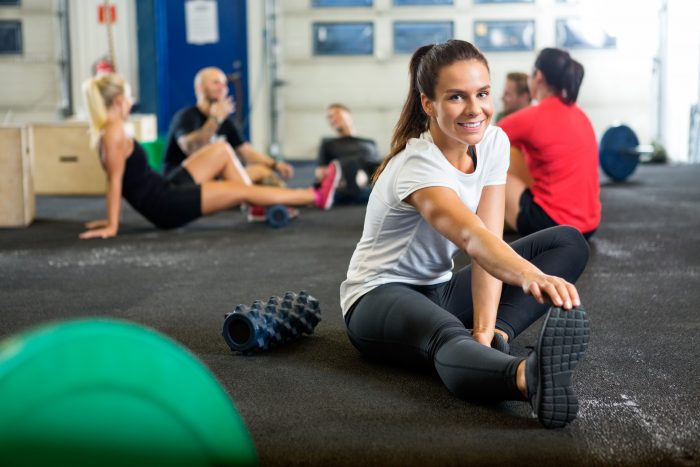Stretch it out!

Over the decades, the concept of stretching has evolved as research continues to shed light on how best to implement this activity into our health routines. Proper stretching can improve flexibility, which increases range of motion (ROM) in joints. Stretching also increases blood flow to the muscles. Altogether, this combination of improved flexibility, ROM and blood flow allows muscles to work more efficiently. In addition to its feel good effects of relieving discomfort in sore muscles, stretching can also help decrease risk of injury and improve performance for those in sports and high-level activities.
While not as heavily studied as some other forms of exercise, research does exist showing the many benefits of stretching when done under certain parameters. A recent study published in the Sports Medicine – Open journal reported that study participants experienced a significant increase in ROM, as well as a significant decrease in passive stiffness and isometric knee flexion force immediately after stretching. Similarly, after a review of literature, the American College of Sports Medicine (ACSM) issued a recommendation that healthy adults should engage in stretching, yoga, tai chi, or a similar flexibility exercise at least 2-3 times per week, with daily sessions “being most effective.”
As awareness of the science behind stretching has become better known, experts agree that it is imperative that stretching exercises be done safely and correctly in order to get the full benefit and prevent injury. Here are a few basic tips to keep in mind for safe stretching:
Take time for a warm up
A 2005 study revealed that dynamic stretching (such as movement going in and out of a stretch position gradually increasing range of motion) led to a significant increase in leg extension power when compared to static stretching (holding a stretch with no movement) or no stretching at all. There is also research which reports that stretching cold muscles can actually cause injury. Findings such as these have led to more attention on the benefits of including a brief warm up before stretching that includes a light aerobic activity (e.g. walking, light jogging) and then stretching movements using the same muscles which will be used during the activity you are about to do. The idea is to prime the body for activity, then start at a lesser intensity of stretches as your body warms up.
Focus on ALL major muscle groups
Your body is designed to work as a complete system. For overall improved flexibility, consider the muscles you use every day. Ensure that your stretching all of them and both sides of the muscle group (e.g. the cat and cow poses in yoga alternate between front and back body stretches). Pay attention to how you lift and move. Likely, you favor one side over the other and notice the difference as you stretch as well. Too much difference from one side to the other can increase your injury risk, so stretching is one way to encourage a balance in overall flexibility.
Discover what feels GOOD for you
Generally, stretching should not hurt. Static stretches, which are commonly used on “warm” muscles after exercise or intensive activity, involve a stretch and hold approach. The ACSM suggests that you “stretch to the point of feeling tightness or slight discomfort.” Once this feeling in the muscle is engaged, pushing it further or over stretching the muscle can cause harm. With continued proper stretching, you may find you are able to stretch farther before this muscle engages as your flexibility grows.
Hold it steady – Don’t bounce
When doing static stretches, once you reach the point where you are safely stretching the muscle, hold it for about 30 seconds. If it’s a problem area, make it a full minute. During this time, do NOT bounce as that can cause injury. Instead, hold it steady and breathe normally. When transitioning between stretches, use gentle, smooth movements.
Also keep in mind that the time suggestion (30-60 seconds) does not have to be done all at once. You can only hold a certain stretch for 20 seconds? No worries. Do the 20 seconds, then repeat that 2 more times. As your body gets stronger and more flexible, you will find it easier to do the stretches for longer periods of time.
Add flexibility to your health goals
As with any exercise, the benefits of stretching exercises come with regular practice. Whether it’s sunrise yoga, making sure to stretch after your midday workout, or winding down with a bedtime stretching routine, remember to also be flexible with your schedule. The benefits of improved flexibility are worth the effort.
If you have questions about proper stretching techniques, ask you doctor of chiropractic about it at your next visit. If you don’t have a regular chiropractor, you can find one here. Learn about stretches that will be best for your current flexibility level as well as modifications that might be appropriate for safe stretching.
REFERENCES:
“The ideal stretching routine.” Harvard Health blog. https://www.health.harvard.edu/staying-healthy/the-ideal-stretching-routine accessed 12/3/19
“Stretching: Focus on flexibility.” Mayo Clinic Staff. https://www.mayoclinic.org/healthy-lifestyle/fitness/in-depth/stretching/art-20047931 accessed 12/3/19
Matsuo S, Iwata M, Miyazaki M, et al. Changes in Flexibility and Force are not Different after Static Versus Dynamic Stretching. Sports Med Int Open. 2019; 3(3):E89–E95. Published 2019 Oct 23. doi:10.1055/a-1001-1993. Accessed 12/3/19.
The New ACSM FITT Recommendations for Hypertension (adapted from 6, 9). American College of Sports Medicine (ACSM) Table. https://www.acsm.org/docs/default-source/files-for-resource-library/fitt-recommendations-for-hypertension_update.pdf?sfvrsn=34b7fe2a_6 accessed 12/3/19
Yamaguchi T, Ishli K. Effects of static stretching for 30 seconds and dynamic stretching on leg extension power. J Strength Cond Res. 2005 Aug;19(3):677-83.